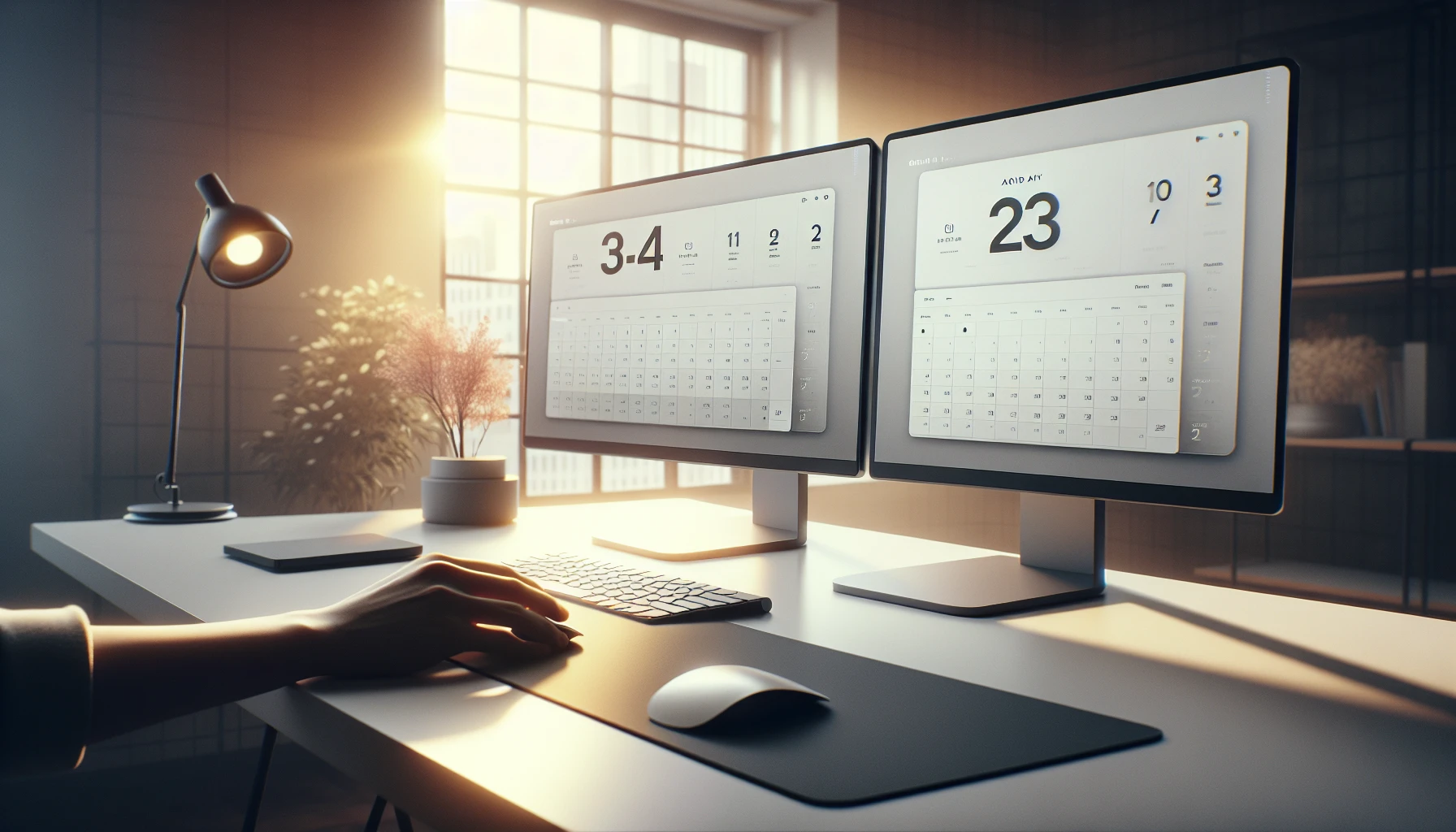· Ricardo Batista · 14 min read
How to reduce no-shows with meeting reminders - Easy tips
Meeting reminders cut no-shows on busy days ; texts, emails and calendar alerts nudge folks to join meetings smoothly on time.

Meeting reminders can be a game changer helping reduce no-shows, clear up confusions and making sure everyone knows what to expect despite hectic schedules. Using a mix of texts, emails and calendar notifications can become a bit messy sometimes, but these little nudges usually do wonders to keep things under control and running without too many hiccups.
Key Takeaways
- Meeting reminders help keep everyone on track by using texts, emails and calendar alerts
- They cut down on no-shows by reminding people about upcoming meetings even if schedules get busy
- We automatically ping the attendees that arrive late to your meetings, making sure no one misses out on key information
- Tools like Calendly and Appointment Reminder offer easy setup and flexibility to fit various needs
- Simple tips like timing the reminders right and clear wording make all the difference in keeping meetings smooth and efficient
The Importance of Meeting Reminders
Meeting reminders are much more than just nudges to show up—they are a crucial tool in keeping your meetings on track. In a world where calendars are jam-packed, it is easy for people to miss or forget meetings. Automated meeting reminders can drive attendance, cut down on no-shows, ensure that participants are on time even if they’re a few minutes late, and ultimately lead to more productive sessions.
With the rise of remote work and virtual meetings, a simple reminder sent via email or text message can be the difference between a successful meeting and wasted time. Sometimes the medium is even as critical as the message, especially when dealing with varied time zones and busy schedules.
Automated Reminders: The Basics and Benefits
Automated reminders save time and reduce errors. They are set up once and then do their job continuously without manual intervention. Here are some reasons why they work so well:
- They save administrative hours by not having to send out manual emails or texts.
- They keep participants informed of any last-minute changes.
- They can be integrated with meeting platforms, ensuring that each scheduled event is automatically followed up with a reminder.
- They boost accountability and give attendees a heads-up about meeting expectations.
Using automated reminders enables you to automatically ping attendees who might be running late. This is especially useful for meetings that run on a tight schedule, ensuring that late arrivals are caught up quickly and not left behind.
Tools for Automated Reminders
There are several tools available that can help streamline your reminder process. Two popular ones include Calendly and Appointment Reminder. These platforms let you set up meeting reminders quickly, freeing you to focus on the more strategic aspects of scheduling.
Calendly
Calendly is a well-known scheduling tool that not only helps with booking meetings but also sends out reminders automatically. This service is popular among young professionals and startup teams because it simplifies the process of scheduling, rescheduling, and sending follow-up communications. With Calendly, you can easily customize the frequency and method of reminders, whether by email or text.
Appointment Reminder
Appointment Reminder is another tool that focuses on sending automated reminders. Its strength lies in how it handles last-minute changes and rescheduling. It can be linked with your existing calendar or scheduling software, ensuring that any changes are immediately communicated to all relevant parties. This kind of integration greatly reduces the risk of miscommunication.
Streamlining Communication Using Advanced Features
When setting up your reminder system, it’s important to build workflows that streamline overall communication. Advanced platforms like Klara and MGMA offer functionalities that go beyond simple reminder notifications. They integrate reminders with comprehensive messaging systems and workflow management solutions.
Klara’s Integrated Communication
Klara provides a solution that is not just limited to reminders. It is designed to integrate with various aspects of your operations. With Klara, automated reminders can be coordinated with other communication events, like follow-ups or confirmations. This ensures a smoother experience for both the organizer and the attendee.
MGMA Workflow Features
MGMA offers similar benefits, particularly for those who manage a variety of appointments throughout their day. Its workflow capabilities can track attendance, follow up with rescheduling options, and even alert teams when someone frequently misses a meeting. This can help identify any recurring issues that may need additional attention.
Actionable Tactics for Reducing No-Shows
Putting your meeting reminder strategy into practice involves a few practical, actionable steps. Here are several tactics that can make a big impact:
Scheduling Windows
Set defined scheduling windows before your meeting. Instead of just sending out a reminder an hour before the meeting, consider multiple notifications:
- A reminder 24 hours before.
- A follow-up 2 hours before.
- A final text message 15 minutes before the meeting begins.
These scheduled windows keep your meeting top-of-mind and give attendees ample opportunities to mentally prepare, adjust their schedules, or inform you if they are running late.
Text Reminders
While email reminders are successful, text reminders bring an additional edge. Text messages are often read within minutes of delivery. Using text messages can ensure that your reminder reaches attendees in real time. This is vital for those who may be on the move or have email notifications turned off on their smartphones.
Automated Late Arrival Reminders
Some tools now offer a feature where a reminder can be sent even if an attendee is late. This automatically pings individuals to let them know that the meeting has started, possibly reducing the disruption caused by late arrivals. This strategy helps keep meetings running on time while giving a subtle push to lagging participants.
Follow-Up and Rescheduling Protocols
No-shows can sometimes be a result of unforeseen circumstances. It is helpful to have an automated follow-up system that checks in with non-attendees after the meeting. Send a request or message prompting rescheduling at a more convenient time. This not only shows commitment to the meeting’s purpose but also respects the attendee’s schedule.
- Create templates for follow-up emails or texts.
- Integrate these templates with tools that can automatically resend or create a rescheduling link.
- Use these templates to also offer additional resources or recordings of the meeting to keep the attendee engaged.
Case Studies and Real-World Guides
There are several practical guides and case studies that offer deeper insights into reducing no-shows. Consider reviewing strategies that have worked for others in a similar space. For instance, Rachel Williams’ strategies on Calendly have become popular among young professionals looking for streamlined scheduling. Her approach often involves a mix of traditional emails and AI-powered reminder tactics.
AI-Powered Tips
Incorporating AI-powered tools can bring a whole new level of efficiency. Some platforms use artificial intelligence to analyze attendance patterns and suggest the optimal times for reminders based on historical data. This approach creates a personalized experience for each attendee, making them more likely to remember and attend their meetings.
Using Case Studies for Process Improvement
Review case studies that include statistical analyses and practical feedback from users. This kind of data can help you fine-tune:
- The timing and frequency of reminders.
- The format (email vs text vs in-app notifications).
- Follow-up procedures for repeated no-shows.
Case studies offer examples of how businesses have reduced no-shows by significant percentages by implementing multi-layered reminder systems. These real-world examples can serve as a blueprint for tweaking your own process.
Leveraging Advanced Tools and External Resources
While many tools are available for meeting reminders, sometimes you need more advanced solutions. External resources like NCBI provide access to scholarly articles and case studies that can help in understanding the behavioral aspects of meeting attendance. This can be especially useful if you want to dig deeper into why people miss meetings and how to tackle that problem.
Citation Management and Research
NCBI is well known for its advanced search features and citation management capabilities. Researchers and professionals can use this platform to gather evidence-based tips that support the development of a robust reminder system. This might help in crafting strategies that are backed by scientific research, offering you a unique edge in designing tailored reminders.
Referencing Additional Guides
For anyone looking for more specific technical help, consider checking these useful resources:
These guides offer step-by-step instructions with tips that are straightforward and ideal for someone who is just stepping into this realm of automated reminders.
Practical Steps for Implementation
Adopting a new meeting reminder system requires a plan. Follow these practical steps to effectively reduce no-shows:
Step 1: Analyze Your Current Schedule
Before jumping into the new system, assess your meeting patterns and identify where no-shows frequently occur. Look at data trends to understand:
- Which meeting times have the lowest attendance rates.
- Whether there is a pattern linked to particular topics or formats.
- How often reminders are currently sent and through which channels.
Step 2: Choose the Right Tools
Based on your analysis, select one or two tools that fit your needs. If you’re looking for simplicity, Calendly might be the best start. For more comprehensive management, consider integrating Appointment Reminder or even a platform like Klara that offers additional messaging capabilities.
Step 3: Set Up Automated Reminders
Establish your reminder system by configuring:
- The timelines you wish to set for reminders.
- Custom messages that resonate with your audience.
- Contact methods (email, text, or even in-app notifications).
Utilize built-in templates provided by most tools, but always feel free to tweak them based on feedback from your team and reminders in action.
Step 4: Create a Follow-Up Process
Plan for what happens after a no-show. This should include an automated follow-up message inviting the attendee to reschedule. By using simple templates, you can ensure that this process is seamless and does not add extra work for team members.
Step 5: Test and Iterate
After implementation, track the results closely. Metrics to observe include:
- Change in attendance rates.
- Feedback from participants.
- Any technical issues or delays in notifications which might need adjustments.
If you identify patterns that need correction, adjust the timing or method of the reminders accordingly. The key is to continuously refine your process for better efficiency and higher engagement.
Step 6: Utilize Internal Templates and Workflow Libraries
Leveraging existing workflow libraries can save time. Many organizations share internal templates for meeting communications which can be adapted for your use. This is a bonus step, but it integrates seamlessly with both automated tools and manual follow-up processes.
Strategies for Handling Late Arrivals
A unique feature of some reminder tools is their ability to send notifications for attendees who have not yet joined but are expected to be active. This helps in minimizing disruptions during the session.
Real-Time Notifications
Some advanced platforms allow you to:
- Automatically detect late logins.
- Send a gentle reminder via text or chat informing the attendee that the meeting is already underway.
- Provide quick instructions on how to rapidly join the conversation.
This real-time approach ensures that even if someone arrives late, they can catch up quickly by referring to shared meeting notes or live recordings provided during the session.
Handling Recurring No-Shows
For those who continuously miss meetings, consider analyzing the data for patterns. A combination of automated follow-ups and a quick call from a team member might reveal underlying issues such as repeated scheduling conflicts. In these cases, using a personal touch can resolve the matter more effectively than automated messages alone.
- Reach out with a brief personal message.
- Ask for feedback on timing or format.
- Offer alternative meeting times that might suit their schedule better.
The consistency of these strategies helps maintain a smooth operation without extra administrative burdens.
Integrating Workflow and Follow-Up
Efficient operations depend on full integration between meeting scheduling, reminder systems, and post-meeting follow-up. When using tools that support automation like Calendly and Appointment Reminder, make sure that all aspects of your workflow are connected.
Seamless Integration with Communication Channels
Ensure that all forms of communication are linked. For example, integrate your Calendly account with your calendar app and email system so that every new meeting automatically generates reminders. Tools like Klara help by offering additional functionality where reminders can trigger further actions such as follow-up emails or even entries into a CRM system.
Using Workflow Libraries
Implement workflow libraries available through your organization or online communities. These libraries provide templates and scripts for:
- Customer follow-ups.
- Rescheduling missed meetings.
- Sending final reminders before the meeting.
By standardizing these processes, you can ensure that all team members are on the same page, and operational discrepancies are minimized.
Customizing Reminders to Fit Your Audience
One size rarely fits all. It is important to tailor your meeting reminders to fit the unique preferences of your audience. Simple language and a friendly tone can make automated messages seem less robotic and more engaging.
Personalization Features
Many platforms allow you to personalize messages by:
- Including the attendee’s name.
- Referring to the mission or purpose of the meeting in a way that feels relevant.
- Adjusting the tone based on whether the meeting is formal or casual.
This added level of personalization not only reduces the chance of a no-show but also builds a positive relationship between the organizer and the attendee.
Timing Adjustments Based on Audience Feedback
Don’t be afraid to change the timing of your reminders. Some audiences appreciate an early warning while others prefer a last-minute buzz before the meeting starts. Gather feedback through short surveys or direct communication, and then tailor your reminder schedule accordingly. This ongoing adjustment is essential for long-term success in reducing no-shows.
Balancing Automation and Human Touch
While automation is fantastic for efficiency, balancing it with human oversight can provide a safety net. Automated messages should act as a reminder system, but the occasional human touch can make a significant difference.
Knowing When to Intervene
If you notice a pattern of continuous no-shows or late arrivals, it might be time for a personal intervention:
- A quick phone call or a personalized email can often address any underlying concerns.
- Direct contact might reveal if the meeting schedule conflicts with other events or personal habits.
Listening and adjusting by mixing automation with a personal approach shows that you care about your attendees’ time and schedule, helping to build a loyal participant base over time.
Using Automatic Tools as Your Backbone
Let your automated reminder system handle the day-to-day communication, but also set aside time for periodic reviews. This balance not only improves adherence to schedules but also ensures that the system remains flexible and responsive to any changes in team dynamics or workload.
With these strategies in place, reducing no-shows becomes a manageable challenge rather than a constant disruption. By leveraging automated tools, personal strategies, and continuous optimization, your meetings are more likely to run on time with engaged participants.
How To Use Google Meets is another quick resource for adjusting meeting settings and ensuring that all participants are equipped with the latest joining protocols, further ensuring your meetings achieve the desired outcome.
Taking these steps will make your meeting reminders more effective and create an environment where every meeting begins on time with all necessary participants engaged.
Conclusion
So, we’ve looked at how meeting reminders can really cut down no-shows and smooth out scheduling hassles. In simple terms, the article showed that automated texts, emails, and calendar alerts make it easier for everyone to remember their meetings, reducing those missed appointments. One key idea is that a quick reminder can help nudge people to join on time, and another is how flexible scheduling tools let you adjust reminders to fit your needs.
We also talked about some of the easiest ways to set up these reminders using common tools, which keep the process simple even when things get a bit hectic. Your next step is to try out these strategies in your own schedule and see how much easier it becomes to keep meetings running as planned. Finally, consider how Meeting Reminders can automatically ping attendees who arrive late to your meetings—it’s a smart fix that can really benefit your overall meeting management.
Related Posts
Frequently Asked Questions (FAQs)
What are meeting reminders?
Meeting reminders are short notifications sent via email, text messages or calendar alerts to remind everyone about an upcoming meeting. They help improve attendance and ensure that everyone is aware of schedule changes.
How can meeting reminders help reduce no-shows?
Using meeting reminders makes sure that people remember their appointments. Even if life gets busy sometimes, a quick message can remind them of the meeting, which often leads to fewer missed appointments.
How do I set up automated meeting reminders using popular tools?
There are several tools you can use, like Calendly or Appointment Reminder. Most tools let you schedule the reminder time, choose the type of notification and automatically send it to everyone. It’s pretty simple if you follow the steps provided on each site.
What makes meeting reminders with automatic pings stand out?
Our system is unique because it can automatically ping the attendees that arrive late to your meetings. This means even if someone is late, they get a quick, friendly nudge to join, keeping your meeting on track. This technique helps maintain order and maximizes efficiency in your schedule.
Are there any best practices for using meeting reminders effectively?
A few tips include setting the reminder time a bit before the meeting, using clear language and making sure the reminder fits your audience. Mix it up between different channels if needed, and always test the system to be sure it works well.



